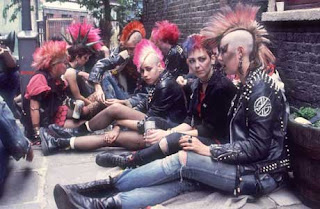Describe the representation of youth in the two posters. What are the connotations of the two texts?
There are many similarities in the both of the film posters. Both youths in each poster appear to be individuals but are in a group as they all share the same fashion sense. The colours of the posters are very similar; both use british flag colours such as blue and red, which connotates that this is a highly British film. Both the youths in these photos are represented as confrontational by the way they are standing in a line all looking in the same direction. This makes both posters gritty and hard hitting.
However there are also differences between the two posters. The poster for This is England is much brighter and colourful, giving connotations that it is more modern. Whereas the poster for Quadrophenia is duller and resembles an old fashioned photograph therefore conveys it is a different time period to This is England. Although This is England uses reviews and a lot of text on the poster making it more appealing to go and see it as they are all very positive, Quadrophenia just has a title and a saying, making it appear less appealing to a reader.
The youths in the ‘This is England’ poster are represented as stereotypical skinheads by their shaven heads and the way they dress (cropped bomber jackets with tight jeans and high boots). This gives connotations that they may be violent as this is a common association with this subculture. The fact that there is only one black person in the poster also conveys that they may be racist as this is often associated with skinheads as well. The environment in this poster conveys that they are working class as they are stood against a run down wall and a council estate can be seen just behind the wall. The girls are well integrated within the group however they all appear to be striking less aggressive poses conveying that they are weaker than the boys. The use of one girl resting her head on the male also gives connotations that the girls are dependent on the boys for safety.
The youths from the ‘Quadrophenia’ poster appear to be from a different subculture. They look as if they are mods from their style including long coats, thin ties and stylish suits. The environment also connotates that they are from working class as they are stood against what appears to be a wooden fence. This is not very glamourous and therefore conveys they are quite common.





